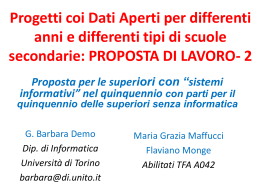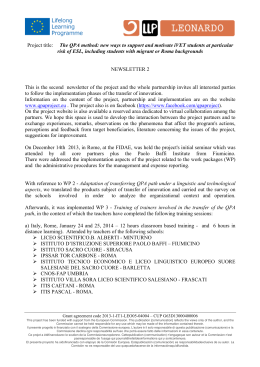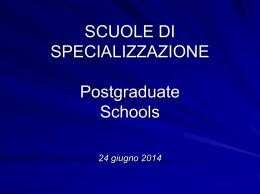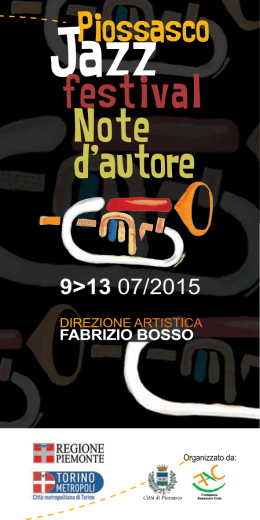Progetti coi Dati Aperti per differenti anni e differenti tipi di scuole secondarie: PROPOSTA DI LAVORO- 1 Proposta per il biennio delle superiori con “discipline” informatiche e per il quinquennio delle superiori senza informatica G. Barbara Demo Dip. di Informatica Università di Torino [email protected] Maria Grazia Maffucci Flaviano Monge Abilitati TFA A042 Uso DATI APERTI I dati aperti sono …. …… • Obama • Problemi • standard di pubblicazione • diritti L’uso dei dati aperti nelle scuole specie in secondarie di II grado è estremamente indicato perchè: • contribuisce al senso civico dei ragazzi facendoli avvicinare ai dati che riguardano tutti, vedendo insieme i siti dove trovarli • significa svolgere una attività didattica che richiede lo sviluppo di un progetto nel suo complesso. Questo tipo di attività interessa molto i ragazzi • Progetto che viene ad integrarsi con quanto molte scuole fanno già: per esempio la certificazione ECDL IOI 2012 2 Uso DATI APERTI nelle scuole secondarie di II grado TECNICHE: • Durante il biennio in molte scuole si propone un programma vicino ai contenuti dell’ECDL troppo spesso ridotto al saper rispondere alle domande dei test di certificazione proponiamo attività di sviluppo di un progetto che va a coprire molti degli aspetti necessari per la certificazione • negli ultimi due anni beneficiano dello stesso approccio e in piú attraverso COMMERCIALI: • durante il biennio • negli ultimi due anni beneficiano dello stesso approccio e in piú attraverso PROFESSIONALI: • durante il biennio beneficiano dello stesso approccio • Altri anni? IOI 2012 3 Uso DATI APERTI nelle scuole secondarie di II grado LICEI SCIENTIFICI SCIENZE APPLICATE: • durante Il biennio • negli ultimi due anni beneficiano dello stesso approccio e in piú attraverso ALTRI LICEI: • durante Il biennio in molte scuole si propone un programma vicino ai contenuti dell’ECDL troppo spesso ridotto al saper rispondere alle domande dei test di certificazione proponiamo attività di sviluppo di un progetto che va a coprire molti degli aspetti necessari per la certificazione • negli ultimi due anni: beneficiano dello stesso approccio e in piú …. astrazione IOI 2012 4 Uso DATI APERTI nelle scuole secondarie di II grado quando? ACCANTO o DOPO L’INTRODUZIONE ALLA PROGRAMMAZIONE E AD UNA VISIONE COMPLESSIVA DI COSA È UN ELABORATORE IOI 2012 5 Very important the pedagogical approach • Keeping in mind the Manifesto mixing Practice, Technique and Science when approaching CS in secondary schools • not to be confused with the European Computer Driviling License ECDL where one learns Officetype of tools - In Italy quite popular • Focusing on how db design and querying a db can profit of competences that in general schools are acquired and are among most valued by students as peculiar of their school-type IOI 2012 6 “Manifesto for Informatics in high school” • May 2010 the main national associations of academic computer scientists from Science and Engineering Faculties (CINI , GII, GRIN) published the “Manifesto sull’Informatica nella riforma della scuola superiore” • This Manifesto still is the reference for the present efforts to change the way informatics is (not) taught in most Italian schools • It points out three different, though related, meanings that the word “Informatics” has for people: 1. Operational or pragmatic: the set of all software and hardware objects; 2. technological: the technology that allows to make such objects and make them work (by programming them); 3. cultural: the scientific discipline that is the foundation of such technology and thus makes it possible. IOI 2012 7 Manifesto for Informatics in schools Operational or Pragmatic : Hardware & software tools to solve everyday problems common perception, you must know how to use some/most popular hw devices and sw tools shared by people who say that Informatics is the set of tools to better understand disciplines in school and thus they (proudly) want computers inside classrooms Technological: knowing systems and languages in order to implement tools technical schools perception Scientific aspect: Informatics is also the (old) science on which sw and hw tools (from the middle of the XXieth century) are funded ISSEP 2011 - Bratislava 8 What do we propose in general secondary schools? • a lot of talking of "open data“ on media • medicine and law are the most popular university careers of general secondary schools students Thus • open data are of interest for several persons active in different areas also intersted teachers and studnts in general sec. schools • We know different problems in medical environment because we often work with physicians (also works with layers): one of them are databases for their research data and enriching the set of queries against such dbs IOI 2012 9 our PROPOSAL After years attempting to have contacts with teachers in the Lyceum type, i.e. general, of secondary schools we decided to face the Classical branch that is the farthest from sciences in general some aspects of the humanities, fostered in the Classic Lyceum, help in activities related to cs: - comprehension of a formal language could be easier for students used to lost languages - text analysis - composing sets and/or using first order logic these students are introduced to in maths or in phylosophy IOI 2012 10 Motivations • Comprehension of a formal language. Translating from a lost language may appear similar to translating from a formal language used to communicate with a computer. IOI 2012 11 La proposta: Optional activitiy of hours for 16-17years old students • Motivation and Introduction – step 1 (2 hours) • Reverse modelling – step 2 (2.5 hours) • From entities and relationships to tables – step 3 (2 hours.5) • Querying tables is composing sets – step 4 (5 hours) • User requirements analysis – step 5 (2.5 hours) • Abstraction levels in db design and in db management systems – step 6 (4 hours) ISSEP 2011 - Bratislava 12 Lavorare su un progetto di sviluppo di una bd • Basato sui dati aperti del MIUR La scuola in chiaro • Usando strumenti di modellizzazione semplici • Usando sistemi di gestione di basi di dati (sgbd) e sistemi al contorno semplici: bisogna facilitare la vita ad insegnanti e studenti • Di cui si percepiscono utilità ma attraverso cui si possono trasmettere concetti dell’informatica come scienza IOI 2012 13
Scarica




